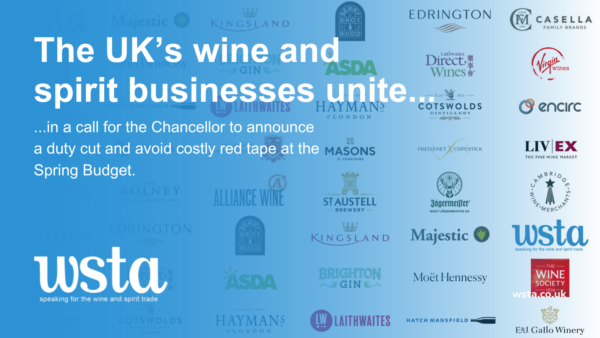Hundreds of UK companies, who qualify, are yet to complete...
Read MoreThe WSTA campaigns each year to ensure a fairer tax environment for the wine and spirit industry in the UK. In 2019, the Chancellor heeded calls from the WSTA and wider industry and passed on a welcome freeze in spirits duty, although he also levied an increase on wine, increasing the price by 7p per bottle of still wine and 9p per bottle of sparkling wine. In the Spring 2020 and Spring 2021 Budgets we secured a freeze on both wine and spirit duties.
How much is tax on wine?

55% Tax
Duty on an average
priced 75cl bottle
=
£2.67
+ £1.08p VAT
How much is tax on spirits?

74% Tax
Duty on an average
priced 70cl bottle
(40% ABV) =
£8.86
+ £2.52p VAT
The over arching rules for charging excise duty are the same for all products, however the rates are different. What is being referred to below is mainly for wine as it is the product that has seen the biggest changes. Spirits based products and spirits drinks below 8.5% and between 8.5% and 22% now pay a slightly lower rate than products over 22%.
You should pay excise duty based on labelled abv, with a strong audit trail to demonstrate that you have labelled products correctly. If discrepancies go beyond allowable tolerances, then you may need to look at relabelling.
The starting point is The Alcoholic Products (Excise Duty) Regulations 2023, known as APED.
There is a hierarchy to follow in regulation 3 when you are looking for the ABV of a finished product:
- by reference to the label on the container
- if there is no label, then by reference to any other document relating to the container
- if there is no label and no reference document, then by testing using the actual strength method
You then go on to identify the abv and applicable tolerances for each product. This may vary between vintages and batches, which creates a bit of a headache for advance print runs of labels. Importantly, tolerances are expressed in terms of “+/-”.
The rule for wine is in Article 44 of this and provides:
Without prejudice to the tolerances set for the reference analysis method used, the strength shown may not differ by more than 0,5 % vol from that given by analysis. However, the alcoholic strength of grapevine products with protected designations of origin or geographical indications stored in bottles for more than three years, sparkling wines, quality sparkling wines, aerated sparkling wines, semi-sparkling wines, aerated semi-sparkling wines, liqueur wines and wines of overripe grapes, without prejudice to the tolerances set for the reference analysis method used, may not differ by more than 0,8 % vol from that given by analysis.
Breaking this down:
- You always have an analysis tolerance, generally accepted at +/- 0.2%
- There is a general tolerance for wine of +/- 0.5%
- PDO wines with > 3 years in bottle, sparkling and liqueur wines and those of overripe grapes have a +/- 0.8% tolerance.
In addition:
- AUS wines have a +/- 0.8% tolerance.
- ABV in the EU is labelled in 0.5% increments.
- ABV in GB is labelled in 0.1% increments – Please see here, a mailshot sent out about this
So taking one example (and assuming it’s not one of the exceptions with a 0.8% tolerance):
- If the analysis of the wine is consistently in the 14.6% – 15% range, then you would take it to be 14.8%.
- For the EU market, that product could be labelled as 14.5% or 15%
- For the GB market, you could label it at any tenth of a degree between 14.3% and 15.3%
- You could not go to 14% in either market
- If the product was intended to go to both EU and GB markets you would label it in accordance with EU standards, which would also meet the UK rules
- For the purposes of the new UK excise duty rates, you would probably choose to label it at 14.3% or 14.5% (and at least for the next 18 months, to advantage of the easement to tax it as if it were 12.5%), unless this was going to be seen as a marketing disadvantage.
Remember also that abv has customs tariff consequences, unless there is a Free Trade Agreement – this could affect wines from the USA, for example.
Despite what Notice 163 currently says about due care, we are optimistic that HMRC have no wish to interfere with long-established labelling rules. We have offered a redraft and HMRC are considering it.
The UK’s wine and spirit sector breathes sigh of relief at a freeze to alcohol duty after disastrous tax hikes
But for wine businesses the benefits of a freeze will...
Read MoreThe UK’s wine and spirit businesses unite in a call for the Chancellor to announce a duty cut and avoid costly red tape, at the Spring Budget
The Wine and Spirit Trade Association along with over 100...
Read More
Call the WSTA Team
020 0789 3877Email:
info@wsta.co.uk
Check our members benefits
Accept Read More



